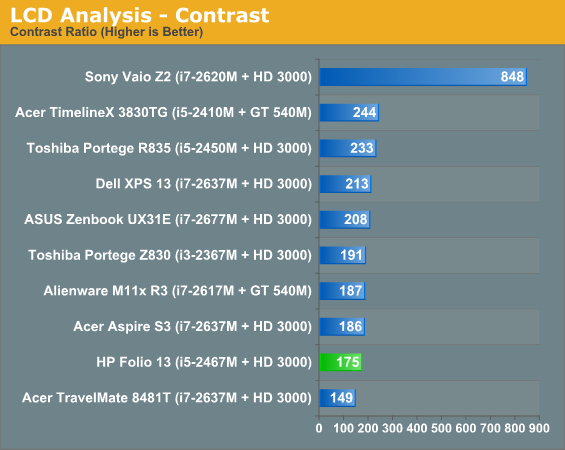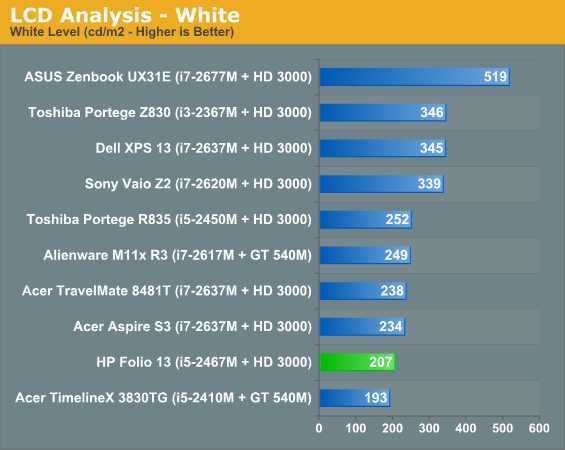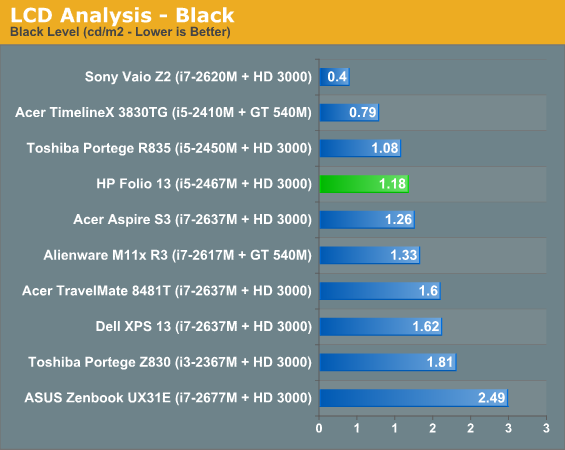HP Folio 13 Review: Deviating From the Norm
by Dustin Sklavos on April 17, 2012 12:30 AM EST- Posted in
- Laptops
- Intel
- HP
- Sandy Bridge
- Ultrabook
In and Around the HP Folio 13
After reviewing nothing but wedge-shaped ultrabooks, the HP Folio 13 is actually a bit of a breath of fresh air. HP's design here doesn't actually deviate all that much from the rest of their notebook lineup; aesthetically it sits right between their consumer and enterprise lines (much as it's intended to), and as I mentioned before they eschewed the wedge shape and kept the build right at the 18mm cusp of Intel's ultrabook spec.
The top lid and interior surface of the Folio 13 are aluminum, while the screen bezel and bottom of the notebook appear to be either carbon fiber or a rubberized treatment on matte plastic; either way, it's soft, light, durable, and attractive. In fact the only gloss on the Folio 13 is surrounding the keyboard and on the screen's interior bezel (which houses the webcam.)
.jpg)
Where HP can claim a major victory with the Folio 13 is the keyboard proper. Ultrabook keyboards, by virtue of the form factor, tend to be very shallow and can be difficult to use. Since HP's engineers seem to have gone in reverse and tried to see how big they could get the Folio while keeping it thin, light, and within spec, the result is a keyboard that has much better depth and travel. It's still not perfect and feels a little on the mushy side, but compared to the others I've tested it's much more comfortable. And as a special bonus: it's backlit.
Unfortunately, despite having an excellent keyboard for an ultrabook, the Folio 13's touchpad is another poorly implemented clickpad. As we've mentioned before and as Anand has even said to me personally, PC vendors still can't seem to get this part of the design down. Honestly I'm at a loss as to why they keep trying, as I have yet to use one that provides a tangible benefit over just using a traditional touchpad and pair of mouse buttons. At this point the only vendor with dedicated mouse buttons on their ultrabook is Toshiba. During testing I found the clickpad had such a hard time detecting misclicks that I was largely forced to use an external mouse.
Finally, the screen on the Folio 13 is another poor-quality 768p TN panel. It's not really worth going through the full rigamarole for something that bothers all of us; suffice to say it's "competitive" with the majority of what's out there in this class, though hopefully the days of dismal notebook screens are drawing to a close as tablet screens push things forward.



The remainder of the results are available in Bench, but you can tell the Folio 13's screen isn't very good even by ultrabook standards. The best in an otherwise bad bunch are the ASUS Zenbook UX31E, which at least sports at 1600x900 resolution, and the vastly more expensive Sony Vaio Z2, which runs at full 1080p but costs nearly twice what some of the other ultraportables do.


_thumb.jpg)
_thumb.jpg)
_thumb.jpg)
_thumb.jpg)
_thumb.jpg)
_thumb.jpg)








88 Comments
View All Comments
LordConrad - Wednesday, April 18, 2012 - link
If laptop makers decide to include higher resolution screens by default, I hope there is an option to downgrade. If the native resolution on my 15 inch laptop was any smaller than 768p, I would have trouble reading it.cbf - Wednesday, April 18, 2012 - link
Go the Windows control panel and increase the point size of your text.A5 - Tuesday, April 17, 2012 - link
Thin & light always has and always will cost more. It requires more R&D effort to fit all this stuff in a small enclosure.sigmatau - Tuesday, April 17, 2012 - link
The R&D to creating this case was so high that manufacturers need to charge a $550 premium over a regular laptop?Really? $550 for a thinner case with the same hardware?
JarredWalton - Tuesday, April 17, 2012 - link
Way to just pull a random number out of your hat. Where do you get $550 from? The lowest sale price of a Core i3 laptop, perhaps? Let me give you a rundown of estimated costs (give or take):i5 ULV CPU: $125 (for an OEM?)
RAM: $25
Custom motherboard: $100
128GB SSD: $100 (for an OEM)
LCD: $65
OS: $50 (OEM price?)
Chassis: $150
Keyboard: $25
Touchpad: $10
Bill of Materials alone, then, I'd estimate at $650 give or take, which is $200 higher than what you're estimating. Now, add in additional R&D costs of $200 to design and mass produce a higher quality (e.g. not injection molded plastic) laptop, and then the profit is looking more like $150. If they sell a ton of these, then the R&D costs are covered and they could conceivably get the price down as low as $700 (on sale), but I wouldn't expect anything lower than that.
ImSpartacus - Tuesday, April 17, 2012 - link
How do you know that? I don't mean to question your BoM, I know it's a rough estimate. I'm just curious as to where one could find that sort of information.I thought it was neat when Mr. Sklavos mentioned the cost of LCD panels (http://www.anandtech.com/show/5717/toshiba-portege... It felt like a natural addition to the article that strengthened his point. And it made those LCD rants easier to read, but that's another story...
Anyway, I know you guys are super busy, but it would be pretty sweet if reviews and stuff referenced material costs if it didn't make the review read poorly.
JarredWalton - Wednesday, April 18, 2012 - link
Actually, I'm the editor of Dustin's articles -- I started adding the LCD pricing comments. :-) Which just makes the issue of low quality panels far more frustrating to me. I'm still working on an article on the topic, but ran into a few snags....The real difficulty with the above pricing is that without actually knowing how much OEMs get charged for some parts, I'm left to go off other sources. I can find some components on the open market, so I can quote those prices (e.g. LCDs, SSDs, CPUs), but what you or I would pay to buy the part is almost certainly quite a bit more than what a large OEM would pay for buying in volume. If you were to buy the equivalent components on your own, prices would be up probably $100 at least from my estimates. Mostly it was a list to point out a reasonable BoM for this laptop.
Super56K - Wednesday, April 18, 2012 - link
If only they played by those rules as far as BoM costs. I'd love to pay an extra ~$50 for a 900p 13" screen. But instead they nail us with a 'premium' upgrade option (if they even give you the option)Even on my 15" HP Probook a 1080p screen upgrade, with a new video cable, is around $100-110 to purchase myself. I'd have gladly paid $500 instead of $380 for it with its 768p screen. Ah well, I'm counting down the months until I decide to void my warranty and 'fix' it myself.
kmmatney - Tuesday, April 17, 2012 - link
I was hoping this meant a 16:10 screen...Oderdigg - Tuesday, April 17, 2012 - link
Really?2nd Gen i5, 4GB, 128 SSD, keyboard backlight, USB 3.0, 1GB NIC and 802.11b/g/n. If they had an i7 or an LED panel, it wouldn't be $1000 anymore. It's also very cool to the touch even under duress so there's a good amount of R&D involved.
I just wish it had a better panel, otherwise it's great.